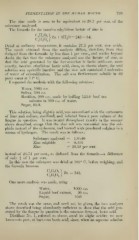Page 789 - My FlipBook
P. 789
—
FERMENTATION IN THE HUMAN MOUTH. 799
The zinc oxide is seen to be equivalent to 28.2 per cent, of the
substance analyzed.
The formula for the inactive ethylidene lactate of zinc is
ri'S'R' \ Zii + SH.O = 243 + 54.
Dried at ordinary temperature, it contains 27.3 per cent, zinc oxide.
The result obtained from the analysis differs, therefore, from that
deduced from the formula by less than 1 per cent., and settles beyond
doubt the fact that the substance analyzed was the lactate of zinc, or
that the acid generated by the fermentation is lactic acid—or, more
exactly, inactive ethylidene lactic acid, since, as shown above, the acid
solution was optically inactive and the zinc salt contained 3 molecules
of water of crystallization. The salt was furthermore soluble in 62
parts water at 14° C.
I repeated the analysis with the following solution :
Water, 1000 c.c.
Saliva, 300 c.c.
Bouillon, 200 c.c, made by boiling 125.0 beef ten
minutes in 300 c.c. of water.
Sugar, 10.0.
This solution, being slightly acid, was neutralized with the carbonates
of lime and sodium, sterilized, and infected from a pure culture of the
fungus in question. It was treated throughout exactly in the manner
above described, except that the zinc salt was converted into the sul-
phide instead of the carbonate, and burned with powdered sulphur in a
stream of hydrogen. The result was as follows :
Substance analyzed — 1.0540
=
Zinc sulphide 0.415
Zinc = 26.38 per cent.
instead of 26.74 per cent., as deduced from the formula—a difference
of only ^ of 1 per cent.
In this case the substance was dried at 100° C. before weighing, and
the formula becomes
^" = '"'
Wk }
One more analysis was made, using
Water, . 1000 c.c.
Liquid beef extract, 20 c.c.
Sugar, 10.0
The result was the same, and need not be given, the two analyses
above described being abundantly sufficient to show that the acid gen-
erated by the fungus in question is the common ferment, lactic acid.
Distillate No. 1, referred to above, owed its slight acidity, we now
know—in part, at least—to lactic acid, since, when an aqueous solution
FERMENTATION IN THE HUMAN MOUTH. 799
The zinc oxide is seen to be equivalent to 28.2 per cent, of the
substance analyzed.
The formula for the inactive ethylidene lactate of zinc is
ri'S'R' \ Zii + SH.O = 243 + 54.
Dried at ordinary temperature, it contains 27.3 per cent, zinc oxide.
The result obtained from the analysis differs, therefore, from that
deduced from the formula by less than 1 per cent., and settles beyond
doubt the fact that the substance analyzed was the lactate of zinc, or
that the acid generated by the fermentation is lactic acid—or, more
exactly, inactive ethylidene lactic acid, since, as shown above, the acid
solution was optically inactive and the zinc salt contained 3 molecules
of water of crystallization. The salt was furthermore soluble in 62
parts water at 14° C.
I repeated the analysis with the following solution :
Water, 1000 c.c.
Saliva, 300 c.c.
Bouillon, 200 c.c, made by boiling 125.0 beef ten
minutes in 300 c.c. of water.
Sugar, 10.0.
This solution, being slightly acid, was neutralized with the carbonates
of lime and sodium, sterilized, and infected from a pure culture of the
fungus in question. It was treated throughout exactly in the manner
above described, except that the zinc salt was converted into the sul-
phide instead of the carbonate, and burned with powdered sulphur in a
stream of hydrogen. The result was as follows :
Substance analyzed — 1.0540
=
Zinc sulphide 0.415
Zinc = 26.38 per cent.
instead of 26.74 per cent., as deduced from the formula—a difference
of only ^ of 1 per cent.
In this case the substance was dried at 100° C. before weighing, and
the formula becomes
^" = '"'
Wk }
One more analysis was made, using
Water, . 1000 c.c.
Liquid beef extract, 20 c.c.
Sugar, 10.0
The result was the same, and need not be given, the two analyses
above described being abundantly sufficient to show that the acid gen-
erated by the fungus in question is the common ferment, lactic acid.
Distillate No. 1, referred to above, owed its slight acidity, we now
know—in part, at least—to lactic acid, since, when an aqueous solution


